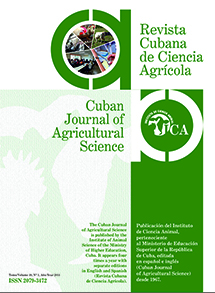Effect of agro-ecosystem and periods of the year upon earthworm population density on silvopastoral systems
Contenido principal del artículo
Resumen
A completely randomized design with three treatments (agroecosystems): A1 (grasses and Alnus acuminata Kunth); A2 (grasses and Acacia melanoxylon R. Br.) and A3 (Grassland) and four periods of the years (PY): 1-12-2015 (1); 1-6-2016 (2); 1-12-2016 (3) and 1-6-2017 (4) in a factorial analysis was conducted to evaluate the effects of agro-ecosystems (AES) and periods of the years upon the earthworm population density (EPD). There was not interaction (p>0.001) between AES and PY upon the EPD. The agro ecosystem A1 (189 m-2) differed (p<0.001) from A2 and A3 with (117 and 128 m-2) while these were similar in earthworms. The periods of the years effect (p<0.001) upon the EPD was higher in PY1 and PY2 (157 and 188 m-2) without differences between them, meanwhile the PY3 and PY4 were similar (118 and 116 m-2) but differed from the previous periods. The best results in the response variable was achieved in A1 agro-ecosystem which coincided with the better forestry indicators
with a mean difference of 1.66 m and 5.84 cm, in height and diameter, respectively. The survival of earthworms and its population density in all agro-ecosystems and periods of the years suggested that EPD is an appropriate bio-indicator to assess the soil health in agroforestry systems and grasslands, closely related with the edaphoclimatic conditions, design and management.
Keywords: agroforestry, soil biota, grassland
with a mean difference of 1.66 m and 5.84 cm, in height and diameter, respectively. The survival of earthworms and its population density in all agro-ecosystems and periods of the years suggested that EPD is an appropriate bio-indicator to assess the soil health in agroforestry systems and grasslands, closely related with the edaphoclimatic conditions, design and management.
Keywords: agroforestry, soil biota, grassland
Detalles del artículo
Cómo citar
Benavides, H. R., Vargas, S., Caicedo, D., Carvajal, L., Gutiérrez, D. I., & Mina, J. (2019). Effect of agro-ecosystem and periods of the year upon earthworm population density on silvopastoral systems. Cuban Journal of Agricultural Science, 53(2). Recuperado a partir de https://mail.cjascience.com/index.php/CJAS/article/view/889
Sección
Ciencia de los pastos y otros cultivos
Aquellos autores/as que tengan publicaciones con esta revista, aceptan los términos siguientes:
- Los autores/as conservarán sus derechos de autor y garantizarán a la revista el derecho de primera publicación de su obra, el cuál estará simultáneamente sujeto a la Licencia Creative Commons Attribution-NonCommercial 4.0 International (CC BY-NC 4.0) que permite a terceros compartir la obra siempre que se indique su autor y su primera publicación esta revista. Bajo esta licencia el autor será libre de:
- Compartir — copiar y redistribuir el material en cualquier medio o formato
- Adaptar — remezclar, transformar y crear a partir del material
- El licenciador no puede revocar estas libertades mientras cumpla con los términos de la licencia
Bajo las siguientes condiciones:
- Reconocimiento — Debe reconocer adecuadamente la autoría, proporcionar un enlace a la licencia e indicar si se han realizado cambios. Puede hacerlo de cualquier manera razonable, pero no de una manera que sugiera que tiene el apoyo del licenciador o lo recibe por el uso que hace.
- NoComercial — No puede utilizar el material para una finalidad comercial.
- No hay restricciones adicionales — No puede aplicar términos legales o medidas tecnológicas que legalmente restrinjan realizar aquello que la licencia permite.
- Los autores/as podrán adoptar otros acuerdos de licencia no exclusiva de distribución de la versión de la obra publicada (p. ej.: depositarla en un archivo telemático institucional o publicarla en un volumen monográfico) siempre que se indique la publicación inicial en esta revista.
- Se permite y recomienda a los autores/as difundir su obra a través de Internet (p. ej.: en archivos telemáticos institucionales o en su página web) antes y durante el proceso de envío, lo cual puede producir intercambios interesantes y aumentar las citas de la obra publicada. (Véase El efecto del acceso abierto).
